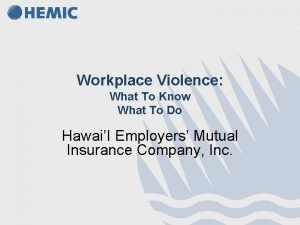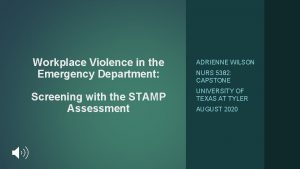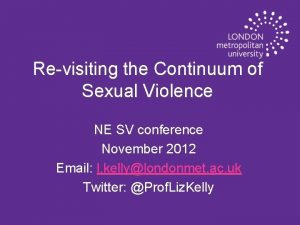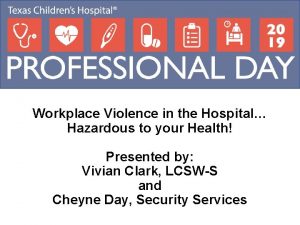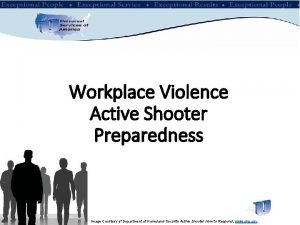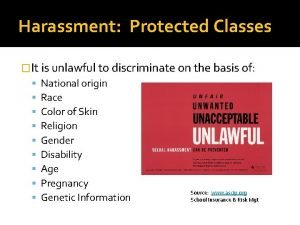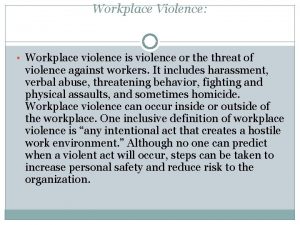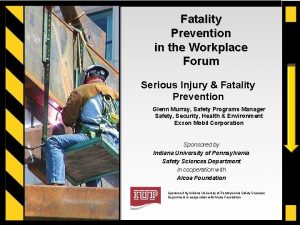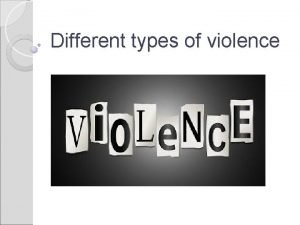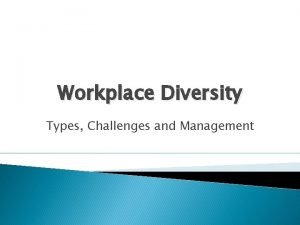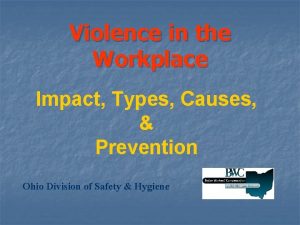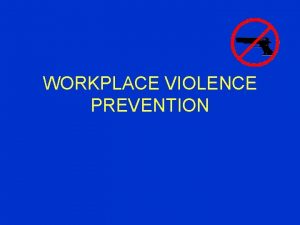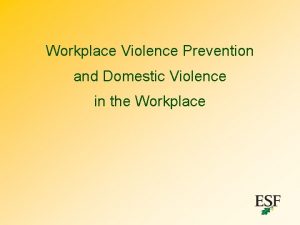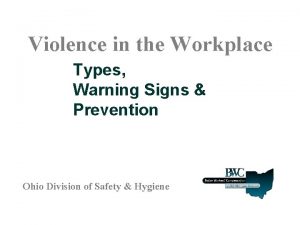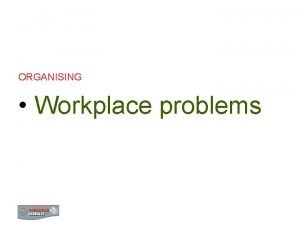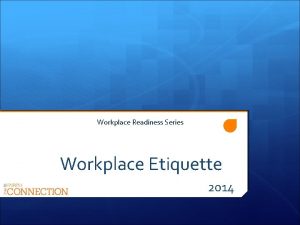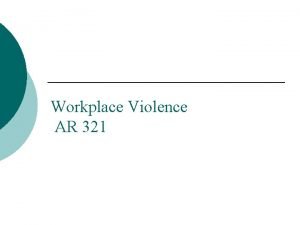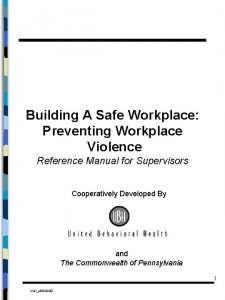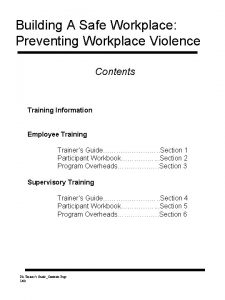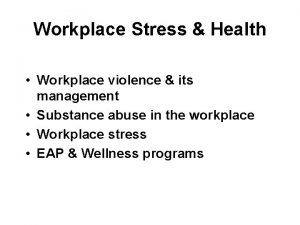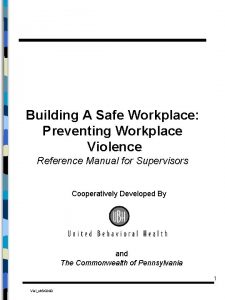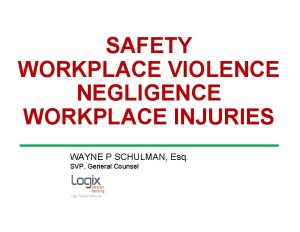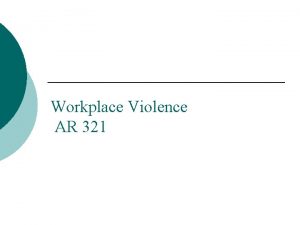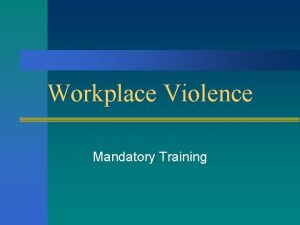Violence in the Workplace Impact Types Causes Prevention











































- Slides: 43

Violence in the Workplace Impact, Types, Causes, & Prevention Ohio Division of Safety & Hygiene

Objectives • Review impact of violence in the workplace • Identify categories of VIWP • Discuss strategies for preventing VIWP • Begin to identify what YOU can do

“We want to believe that human violence is somehow beyond our understanding, because as long as it remains a mystery, we have no duty to avoid it, explore it, or anticipate it. ” The Gift of Fear by Gavin de Becker

“. . the path toward violence is an evolutionary one, with signposts along the way. ” The School Shooter: A Threat Assessment Perspective by Mary Ellen O’Toole, Ph. D

How serious is the problem? • Almost 2 million assaults and threats per year plus 84, 000 robberies per year. • In 1997, 45. 6% of all workplace homicides occurred in retail trade. Source: Compensation and Working Conditions, Fall 1999

Workplace Deaths • Homicide is the 2 nd leading cause of death in the workplace • Worker on worker violence resulting in death only represents 4%; The remainder is from robberies, assaults from customers, patients, etc.

Definitions · Harassment · The act of someone creating a hostile work environment through unwelcome words, actions or physical contact or stalking behavior NOT resulting in physical harm. · Threat · An expression of an intent to cause physical harm at that time or in the future. Any words, slurs, gestures, stalking behavior or display of weapons which are perceived by the worker as a clear and real threat to their safety and which may cause fear, anxiety or the inability to perform job functions.

Definitions · Physical Attack · With or without the use of a weapon, a physical attack is any aggressive act of hitting, kicking, pushing, biting, scratching, sexual attack or any other such physical act directed to the worker by a coworker, patient, client, relative or associated individual which arises during or as a result of the performance of duties and which results in death or physical injury. · Workplace Violence · Unwelcome physical or psychological forms of harassment, threats or attacks that cause fear, mental or physical harm or unreasonable stress in the workplace.

Examples • Verbal threats to inflict bodily harm • Attempting to cause physical harm; striking, pushing or other aggressive acts • Disorderly conduct such as shouting, throwing or pushing objects, punching walls, and slamming doors.

Examples • Verbal harassment; abusive or offensive language; gestures or other discourteous conduct • Making false, malicious, or unfounded statements against coworkers to damage their reputation or undermine their authority • Fascination with guns or other weapons; bringing weapons to the workplace

VIWP Types

Type 1: By a Stranger • • • robber arsonist terrorist rapist sociopath “road rage”

Types II: By a Customer or Client: • • client customer patient student • • inmate relative vendor contractor

Type III: Internal to Company • employee • supervisor • former employee

Type IV: By Personal Relations • Having a personal relationship with an employee (real or imagined)

VIWP Types: So what? • counters “randomness” argument • breaks down the problem – different causes – different solutions needed

Dangerous Ingredients Toxic Work Environment Troubled Employee Park Deitz’ model Trigger Event

Personal Anger Escalation critical event physically threatening verbally hostile agitated calm

Causes

Psychological & Social • • Personal expectations Culture change Domestic spill-over Reduced trust Reduced caring Less control Media influence

Jobs-Economy • • • Downsizing “Jobs” vs. “Careers” Personal identity from job Labor-management tension Negligent hiring & retention

Denial • VIWP is not a big problem. • Even if it is, it’s not a problem here. • I can’t do anything about it anyway. • It’s a social, not a workplace, problem.

Stress • Fear of losing job • Other major life-changing event • Substance abuse • Personal problems • Feelings of oppression

Leadership Style • Autocratic management / supervisory style • Managers out of touch with workers • Organizational change • Unrealistic expectations • Unfair allocation of tasks

Warning Signs

Warning Signs - Type 1 • Increased crime in the area • Incidents in similar industry or workplace • Employee concerns • Special or unique conditions: time of year, local events • Poor or no security • Poor environmental design


Warning Signs - Type 2 • Increased number of complaints from a client, etc. • Increased number of complaints with one product or service • Security breaches • “Close call” • Employee concerns


Warning Signs - Type 3 • Has a history of interpersonal conflict, is argumentative or uncooperative • Has difficulty accepting authority or criticism • Tends to blame others for problems • Decreased social connection with little or no family support • Significant changes in behavior, performance, or appearance

Warning Signs - Type 4 • distraught employee • evidence or claims of harassment • suspicious person on property

Prevention

Pre-hiring Checks • Criminal background check • Driving record (if applicable) • Check references carefully – employers, supervisors, coworkers • Ask open-ended questions during the interview • Verify credentials • Test for drug use

Management Commitment & Leadership Style • • • Recognize potential problem Use labor-management partnership Be a communicator, facilitator, expediter Be fair, honest, open Implement a VIWP policy

Zero Tolerance Policy • Elements (purpose, definitions, reporting procedure, investigation, disciplinary action) • Non-retaliation • Clear expectations • Forms • Organizational “buy-in”

Employee Involvement • Participation and support in determining policies • Assist with risk assessment • Helping co-workers deal with stress • Communication throughout the organization • Input on training needs

Risk Assessment • • • Workplace security analysis Customer flow / Hours of operation Treatment of customers / clients Training of personnel Restricted areas Installation of panic-buttons


Crisis Team • Represents the entire organization • Serves as employees’ liaison • Addresses policies and procedures, training needs, documentation, etc.

Training Topics • • VIWP: what it is Workplace violence prevention policy Assault risk factors Recognizing warning signs Diffusing volatile situations Ways to protect oneself & co-workers Incident reporting

Documentation • Purpose of documentation (to determine severity, to evaluate control methods, to identify training needs) • Injuries, incident reports • Risk assessment results • Corrective actions • Training

Summary • • Actively address VIWP issues Assess the risk of violence Involve employees Consistently apply standards Document incidents & take threats seriously Create a VIWP policy Train all employees

Questions ?
 Primary prevention secondary prevention tertiary prevention
Primary prevention secondary prevention tertiary prevention Indicators of potential workplace violence:
Indicators of potential workplace violence: Indicators of potential workplace violence
Indicators of potential workplace violence Stamp violence assessment tool
Stamp violence assessment tool Workplace violence continuum
Workplace violence continuum 3 phases of escalating behavior workplace violence
3 phases of escalating behavior workplace violence Workplace violence
Workplace violence Dhs workplace violence
Dhs workplace violence Workplace violence and harassment quiz answers
Workplace violence and harassment quiz answers Type 3 workplace violence
Type 3 workplace violence Workplace fatality prevention
Workplace fatality prevention Different types of violence
Different types of violence Types de la violence
Types de la violence Ultimate cause of behavior
Ultimate cause of behavior Proximate causes vs ultimate causes
Proximate causes vs ultimate causes Workplace types and the economy
Workplace types and the economy Conclusion of diversity
Conclusion of diversity Types of research impact
Types of research impact Hát kết hợp bộ gõ cơ thể
Hát kết hợp bộ gõ cơ thể Slidetodoc
Slidetodoc Bổ thể
Bổ thể Tỉ lệ cơ thể trẻ em
Tỉ lệ cơ thể trẻ em Gấu đi như thế nào
Gấu đi như thế nào Tư thế worm breton
Tư thế worm breton Alleluia hat len nguoi oi
Alleluia hat len nguoi oi Kể tên các môn thể thao
Kể tên các môn thể thao Thế nào là hệ số cao nhất
Thế nào là hệ số cao nhất Các châu lục và đại dương trên thế giới
Các châu lục và đại dương trên thế giới Công thức tính thế năng
Công thức tính thế năng Trời xanh đây là của chúng ta thể thơ
Trời xanh đây là của chúng ta thể thơ Cách giải mật thư tọa độ
Cách giải mật thư tọa độ Làm thế nào để 102-1=99
Làm thế nào để 102-1=99 độ dài liên kết
độ dài liên kết Các châu lục và đại dương trên thế giới
Các châu lục và đại dương trên thế giới Thể thơ truyền thống
Thể thơ truyền thống Quá trình desamine hóa có thể tạo ra
Quá trình desamine hóa có thể tạo ra Một số thể thơ truyền thống
Một số thể thơ truyền thống Cái miệng xinh xinh thế chỉ nói điều hay thôi
Cái miệng xinh xinh thế chỉ nói điều hay thôi Vẽ hình chiếu vuông góc của vật thể sau
Vẽ hình chiếu vuông góc của vật thể sau Biện pháp chống mỏi cơ
Biện pháp chống mỏi cơ đặc điểm cơ thể của người tối cổ
đặc điểm cơ thể của người tối cổ Ví dụ về giọng cùng tên
Ví dụ về giọng cùng tên Vẽ hình chiếu đứng bằng cạnh của vật thể
Vẽ hình chiếu đứng bằng cạnh của vật thể Vẽ hình chiếu vuông góc của vật thể sau
Vẽ hình chiếu vuông góc của vật thể sau


